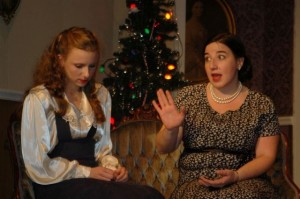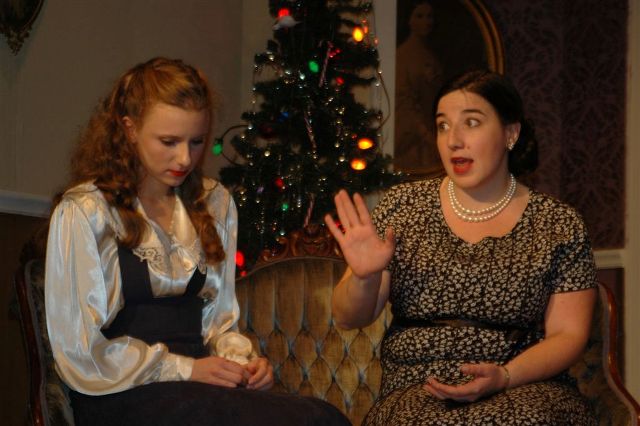Alfred Uhry, the playwright of DRIVING MISS DAISY, drew on his memories of Atlanta and its German-Jewish families to write THE LAST NIGHT OF BALLYHOO. He set his play in 1939 amid the unsettling news of Hitler’s advances and subtle anti-semitic rumblings in the US. What he really reveals to us in this episodic script are the conflicts within the Freitag and Levy families. Both stated and unsaid are the tensions of a family business, the price of assimilation, the class distinctions within their Jewishness, and the importance of social standing.

Jane Schumacher and Jen Adams in a scene from The Stagecrafters' THE LAST NIGHT OF BALLYHOO, running in Chestnut Hill (Philadelphia) through December 12. (Photo credit: Sara Stewart)
To do this Uhry created for us two Levys (Boo and her daughter Lala) and three Freitags (Reba and her Daughter Sunny and her Brother-in-law Adolph). Add in an outsider Joe Farkas (A Jew of Middle European ancestry) and Peachy Weil (of the Louisiana Weils) and Ballyhoo (a prom like ball held at Christmas time) and you have the basis for the plot.
Director Loretta Lucy Miller, who stepped in when Marilyn Yoblick had to relinquish her duties because of a family member’s illness, has led a fine cast in this production. She kept the many scenes moving along and mined the play for its unstated truths.
Jen Adams (Boo Levy) found the balance between concern for her daughter’s social position and her own anger about her position in the family business. As Lala, Jane Schumacher is a model of insecurity and teen age angst. Her cousin Sunny, played by Sara Romig, is every bit the college student. She conveys the character’s quest for knowledge and understanding of herself and her religion with an understated and fine tuned performance. Russ Tisinger played Joe Farkas with an understanding of “not belonging” and the appropriate anger at its consequences. His New York accent stood the test against the good southern accents of the rest of the cast. His is a very good performance in the role that moves the action along.
The empty headed but happy Reba Freitag was in played by Nancy Bennett with a breeziness that I appreciated. Her brother-in-law, Adolph Freitag, was played by Richard Geller. He displayed a weariness and world concern and yet a tenderness toward his niece and his sister. Carl Heyde made the most of his annoying character, Peachy Weil. I couldn’t help wondering about that wonderful red/orange hair.
The set was extremely well done. I felt at home in the living room of the Atlanta home (except for the Christmas tree). The tree is an example of the assimilation of the families. It made its point in the first minutes of the play. The lighting and sound were so good they were taken for granted.
THE LAST NIGHT OF BALLYHOO deserves more of an audience than I saw at this performance. It says a lot about a lot.
THE LAST NIGHT OF BALLYHOO
by Alfred Uhry
Directed by Loretta Lucy Miller
November 26 – December 12, 2010
The Stagecrafters
8130 Germantown Ave
Chestnut Hill, PA
(215) 247-8881
www.thestagecrafters.org


